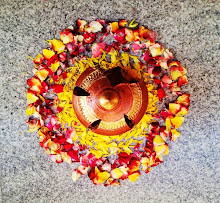A book review I did for the office magazine...
Riot is set in 1989 in Zalilgarh, a small town in U.P where an American student visiting India - Priscilla Hart - becomes a victim of a Hindu- Muslim riot. A few weeks later, Priscilla's parents travel to India to find out what happened. The rest of the story unfolds the circumstances around her death, which becomes the pretext for a thoughtful novel about the religious tensions plaguing India. As Shashi Tharoor mentions, the plot took form when a college friend, an IAS officer, sent him an account of a riot he had dealt with as a district magistrate and thus Riot became a medium to bring out the various view-points regarding the Hindu-Muslim tensions in India.
The novel covers the perspectives of a well chosen set of characters – a progressive thinking district magistrate, a Sikh superintendent of police, an American reporter, a Muslim academic and the head of the local Hindu fraction, among others. The novel covers a vast spectrum of historical events which are seamlessly integrated with the main plot – right from Coca Cola’s first entry and subsequent exit from India to Operation BlueStar – all narrated through the eyes of different characters.
The novel covers the perspectives of a well chosen set of characters – a progressive thinking district magistrate, a Sikh superintendent of police, an American reporter, a Muslim academic and the head of the local Hindu fraction, among others. The novel covers a vast spectrum of historical events which are seamlessly integrated with the main plot – right from Coca Cola’s first entry and subsequent exit from India to Operation BlueStar – all narrated through the eyes of different characters.
The other theme which provides an undercurrent to Riot is the dichotomy of Indian thinking which so puzzles the rest of the world. As one of the characters says “I’m Indian. I enjoy Beatles and Bharat Natyam. I act in Oscar Wilde plays and I eat with my fingers. I read Marx, and I let my parents arrange my marriage.” The novel explores the psyche of the typical Indian caught balancing between deep-rooted Indian sentiments and their own progressive thinking.
While the plot itself makes for a compelling read, the narrative just makes it unputdownable. Tharoor has a masterful narrative style with the book taking the shape of a compilation of journals, transcripts, letters, newspaper extracts, scrapbooks and even poems written by some of the characters. The form of writing gives Tharoor the space to experiment with the narrative and write from the perspective of various characters. As the author says through one of his characters, “I’d like to write a novel that doesn’t read like a novel (…) something in which you can turn to any page and read. You pick up chapter 23, and you get one thread of the plot. Then you go forwards to chapter 37, or backwards to 16, and you get another thread. (…) you see the interconnections differently depending on the order in which you read them.” Through Riot, Tharoor has definitely achieved this.






















No comments:
Post a Comment